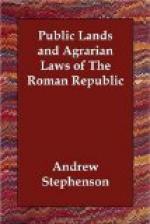[Footnote 1: Cato, De Re Rustica, I, lines 3-8. “Majores nostri ... virum bonum cum laudabant, ita laudabant, bonum agricolam bonumque colonum. Amplissime laudari existimabatur, qui ita laudabatur.”]
[Footnote 2: Muirhead, Roman Law, 36 et seq.]
[Footnote 3: Varro, De Lingua Latina, V, 143.]
[Footnote 4: Frag, to Digest, 287 and 147 of Title 16, Bk. 50 with notes of Schultung and Small.]
[Footnote 5: Plutarch’s Romulus, Sec. 19.]
[Footnote 6: Mommsen, History of Rome, l, 194.]
[Footnote 7: Sismondi, Etudes sur l’econ. polit., 1, 2, Sec. 1.]
[Footnote 8: Pseudo Fabius Pictor, Bk. I, p. 54; Plut., Numa, 16; Festus V deg. Pectustum Palati, p. 198 and 566, Lindemann.]
[Footnote 9: Arnold, Roman History, I, ch. 3, par. 4.]
[Footnote 10: Mommsen, I, 75.]
[Footnote 11: Strabo, Bk. 5, 253.]
[Footnote 12: Strabo, Bk. 5, ch. 3, Sec. 2.]
[Footnote 13: Arnold, I, ch. 3.]
[Footnote 14: Dionysius, II, 55; V, 33, 36; III, 49-50; Livy, I, 23-36.]
[Footnote 15: Dionysius, IV, 13.]
[Footnote 16: Varro, De Lingua Latina, V, 33.]
[Footnote 17: Sigonius, De Antiq. Juris Civ. Rom., Bk. I, ch. 2.]
[Footnote 18: Hume’s Hist, of Eng., I, ch. 4: IV, ch. 61.]
[Footnote 19: Esprit des lois, Liv. 27, c. 1.]
[Footnote 20: Roman Hist., II, 164; III, 175 and 211.]
[Footnote 21: Lycurgus and Numa, II; Cicero, De Repub., II, 9.]
[Footnote 22: Muirhead, Roman Law, 46 and note—“uti legasset suae rei ita jus esto.”]
[Footnote 23: Muirhead, 92-96.]




